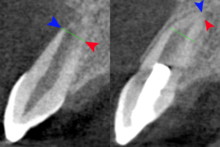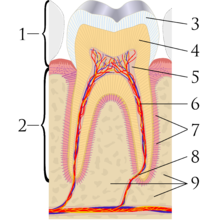Regenerative endodontics
Regenerative endodontics ( English : Regenerative endodontics ) refers to processes of biological regeneration for the restoration of destroyed internal tooth structures such as dentin , tooth roots and tissues of the tooth pulp . The procedure is mainly used in the case of incomplete root growth for therapy in the presence of irreversible or acute pulpitis , pulp necrosis and apical periodontitis .
Demarcation
In cases of incomplete root growth, an infected pulp is apexified with calcium hydroxide or an apical closure with mineral trioxide aggregate (MTA). The methods have the disadvantage that no vital cells remain in the root canal and thus no further root growth can take place. The aim of the new revitalization process is to bring the root growth to completion by mobilizing stem cells from the area of the apical papilla into the root canal. Regenerative endodontics is an extension of root canal treatment .

In order to replace the tissue, either existing cells are stimulated to increase their growth or bioactive substances are used, especially stem cells , growth factors , morphogens , tissue scaffolds and biologically active enhancement systems.
Closely related to this are clinical methods of apexification and apexogenesis (physiological development of the root tip). During apexogenesis, part of the tooth pulp is preserved and stimulated for regeneration. Cells of the periapical tissue are stimulated to form dentin-like substances at the end of the tooth root, on the apical foramen . The aim is for the diseased tooth to form new tissue and extend its lifespan.
The necrotic pulp and the open root ends can be stimulated to new growth by platelet rich fibrin (PRF). The application of the PRF was developed by the French dentist Joseph Choukroun.
State of research
There are currently numerous case reports. However, it is necessary that controlled and randomized clinical studies are carried out, which provide a uniform protocol for the measures of revascularization.
In January 2017, a work on regeneration by a collagen sponge with glycogen synthase kinase 3 (GSK-3) was published at King's College London .
literature
- E. Schneider1, S. Jepsen1, H. Dommisch, Revascularization of vital teeth Dtsch Zahnärztl Z 2014, 69: pp. 144–151. Retrieved June 2, 2017.
- Dentin matrix proteins and regenerative endodontics. In: ZWR - Das Deutsche Zahnärzteblatt. 125, 2016, p. 173, doi: 10.1055 / s-0036-1582312
- Jeremy J. Mao, Sahng G. Kim, Jian Zhou, Ling Ye, Shoko Cho, Takahiro Suzuki, Susan Y. Fu, Rujing Yang, Xuedong Zhou: Regenerative Endodontics. In: Dental Clinics of North America. 56, 2012, p. 639, doi: 10.1016 / j.cden.2012.05.005 .
- Bin-Na Lee, Jong-Wook Moon, et al., A review of the regenerative endodontic treatment procedure. In: Restorative Dentistry & Endodontics. 40, 2015, p. 179, doi: 10.5395 / rde.2015.40.3.179 .
Individual evidence
- ↑ Kenneth M. Hargreaves, Stephen Cohen: Pathways of the Pulp. 10th Edition, Mosby Elsevier, St. Louis , Missouri , US 2011: 602. ISBN 978-0-323-06489-7
- ↑ Kenneth M. Hargreaves, Stephen Cohen: Pathways of the Pulp. 10th Edition, Mosby Elsevier, St. Louis , Missouri , US 2011: 602-618.
- ↑ Kenneth M. Hargreaves; A. Diogenes; FB Teixeira: Treatment options: Biological basis of regenerative endodontic procedures. In: Pediatric dentistry. vol. 35, 2: 129-140, 2013. (pmid = 23635981)
- ↑ Dexton Antony John; S. Vidyanath; M. Ramesh Kumar; Vasundara Yayathi Shivashankar: Platelet Rich Fibrin in the revitalization of tooth with necrotic pulp and open apex. In: Journal of Conservative Dentistry. vol. 15, 4, 2012: 395-8 (issn 0972-0707; doi = 10.4103 / 0972-0707.101926 pmid = 23112492.
- ↑ Recommendation on the use of autologous blood and autologous blood products in dentistry, oral medicine and maxillofacial medicine , Scientific Communication from DGZMK , German Dental Journal , Deutscher Ärzte-Verlag , 2013; 68 (5). Retrieved June 2, 2017.
- ↑ Paul. T. Sharp; Dhivya Chandrasekaran; Rebecca Babb; Vitor CM Neves Neves: Promotion of natural tooth repair by small molecule GSK3 antagonists. In: Scientific Reports. vol. 7, 2017. (doi 10.1038 / srep39654)
